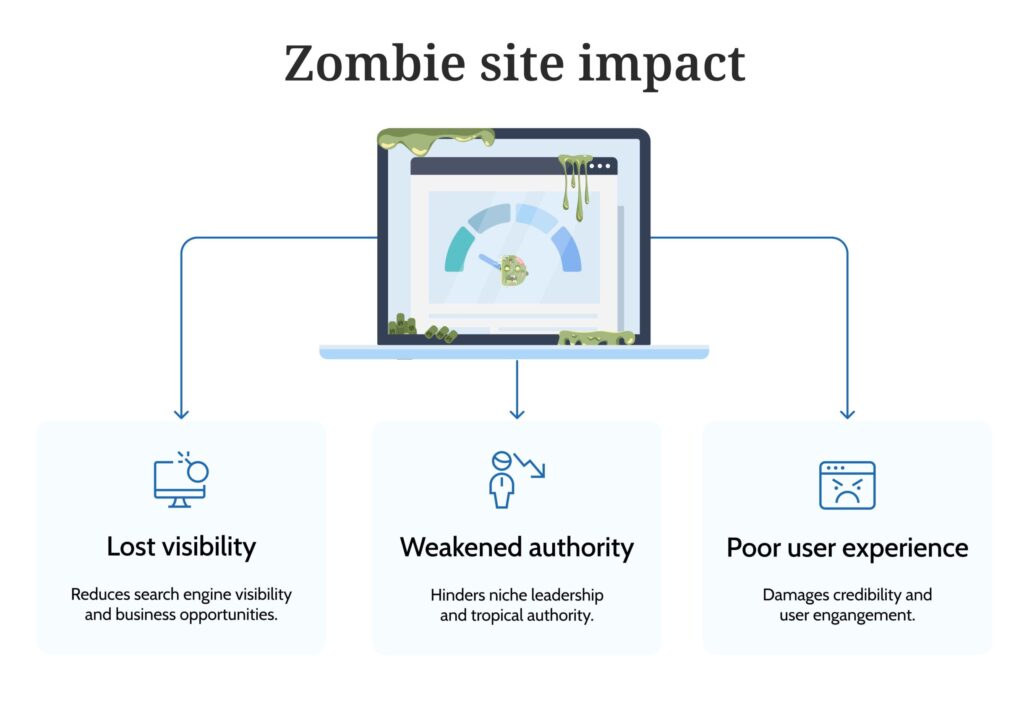In B2B marketing, website is more than an online brochure, it’s a lead generation engine, a trust builder, and a key driver of long-term growth.
However, without regular oversight, a once-effective website can slowly lose its ability to attract and convert the right audience.
Many business websites slowly transform into what’s known in SEO as a zombie site filled with outdated, low-value pages that not only fail to bring in traffic but also actively harm your visibility in search.
In this article, we explore what a zombie site is, why content freshness is critical for modern SEO, the long-term damage zombie content can cause to your business, and how to recover.
What is a zombie site?
A zombie site is a website bloated with underperforming pages: often outdated, irrelevant, or lacking in depth. These pages may have been useful once, but over time, they’ve become invisible to users and search engines alike.
In fact, a study by Ahrefs found that 96.55% of all web pages receive no organic traffic from Google, based on an analysis of over 14 billion pages. This highlights just how common ineffective — or “zombie” — content has become across the web.
Why freshness matters in modern SEO
Google’s algorithm increasingly rewards fresh, up-to-date content, especially in sectors where trends, technology, compliance, or industry standards evolve rapidly, like IT, finance, healthcare, or logistics.
A study by HubSpot found that companies that published 16 or more blog posts per month received 3.5 times more traffic and 4.5 times more leads than companies that published zero to four blog posts per month.
For B2B businesses, outdated content signals stagnation. If your blog hasn’t been updated in 18 months, or your “solutions” pages still reference obsolete technology, Google is less likely to prioritise your site in search results and potential clients may question your credibility.
In modern SEO, freshness is not just a ranking factor, it’s a trust factor.
How a zombie site damages your business and SEO performance
1. Lost visibility and missed business opportunities
When outdated or irrelevant content dominates your website, it becomes harder for search engines and your prospective clients to identify and reach your most important offerings.
This loss of visibility doesn’t just affect traffic; it reduces your share of voice in key industry conversations and limits your ability to attract qualified enquiries.
In competitive B2B markets, where timing and trust matter, this can result in prolonged sales cycles, missed partnership opportunities, and reduced pipeline performance.
2. Weakened topical authority
Outdated and irrelevant content clouds your site’s core themes, making it harder for Google to identify you as a leader in your niche.
3. Poor user experience: damaged credibility and user engagement
Stale pages with outdated information damage credibility. B2B buyers are less likely to engage or convert on a site that appears inactive or out of date.
Additionally, irrelevant content frustrates users, increasing bounce rates, and reducing engagement.
Now, 62% of B2B buyers engage with between three to seven pieces of content before contacting a sales representative, meaning that maintaining a repository of fresh, relevant content is crucial to supporting the buyer’s journey and building trust.
Why you need to recover as soon as possible
The longer zombie content lingers on your site, the deeper its negative impact becomes, not just on rankings, but on how your brand is perceived and how effectively your site drives conversions.
Google does not simply forget low-quality content over time. Instead, Google evaluates the overall quality and relevance of your entire domain.
This means underperforming pages can pull down the ranking potential of your strongest assets such as service pages, case studies, and thought leadership pieces, regardless of how well-optimised they are.
Studies show that updating and republishing old blog posts with new content and images can increase organic traffic by up to 106%, highlighting the importance of refreshing outdated content to maximize its effectiveness.
From a commercial standpoint, delaying recovery:
- Allows competitors with fresher content to outrank you.
- Erodes trust with repeat visitors and existing clients.
- Lowers ROI from ongoing content or SEO investments.
In B2B, where decision cycles are long and customer trust is critical, every month of inaction is a missed opportunity to convert organic traffic into leads and deals.
How to recover from a zombie site situation
Addressing a zombie site issue requires more than just deleting a few old pages, it demands a thoughtful and strategic approach to content governance.
The first step is to gain clarity on the scope of the problem by evaluating the relevance, performance, and alignment of existing content with current business goals. This isn’t about chasing every low-performing blog post; it’s about identifying which content no longer reflects your company’s expertise, solutions, or positioning.
Once outdated or redundant content has been identified, there are typically three clear courses of action: it can be removed entirely, merged with other content to create a stronger and more authoritative resource, or refreshed (content rewrite) to bring it in line with the current market, audience expectations, and SEO best practices.
Beyond content clean-up, it is essential to review how content is structured and interconnected across your site. Key assets such as solution pages, whitepapers, or industry insights must be prominently featured and internally linked to guide both users and search engines toward the most valuable areas of your website.
To prevent the problem from recurring, organisations need to implement a forward-looking content management plan. This means regularly reviewing the performance and relevance of content, aligning new content creation with strategic objectives, and ensuring your messaging remains consistent with your evolving brand and offerings.
At Manning & Co., we understand that strategic content is central to building brand authority and long-term business growth.
With our expertise in strategic marketing and content creation, particularly big rock assets and thought leadership, we can help you develop a comprehensive content strategy that aligns with your business goals and drives tangible results.
Contact us today to learn how Manning & Co. can help you revitalise your digital presence, enhance content performance, and turn your website into a trusted, high-performing asset for your business.





